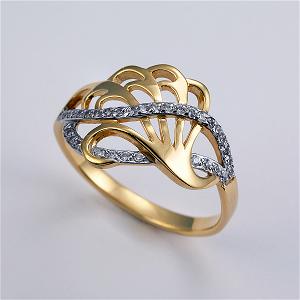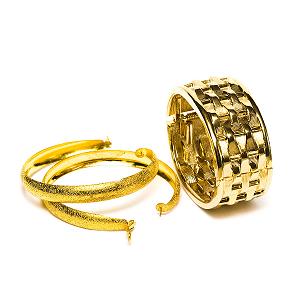 Jewellery or jewelry consists of small decorative items worn for personal adornment, such as brooches, rings, necklaces, earrings, and bracelets. Jewellery may be attached to the body or the clothes, and the term is restricted to durable ornaments, excluding flowers for example. For many centuries metal, often combined with gemstones, has been the normal material for jewellery, but other materials such as shells and other plant materials may be used. It is one of the oldest type of archaeological artefact – with 100,000-year-old beads made from Nassarius shells thought to be the oldest known jewellery. The basic forms of jewellery vary between cultures but are often extremely long-lived; in European cultures the most common forms of jewellery listed above have persisted since ancient times, while other forms such as adornments for the nose or ankle, important in other cultures, are much less common. Historically, the most widespread influence on jewellery in terms of design and style have come from Asia.
Jewellery or jewelry consists of small decorative items worn for personal adornment, such as brooches, rings, necklaces, earrings, and bracelets. Jewellery may be attached to the body or the clothes, and the term is restricted to durable ornaments, excluding flowers for example. For many centuries metal, often combined with gemstones, has been the normal material for jewellery, but other materials such as shells and other plant materials may be used. It is one of the oldest type of archaeological artefact – with 100,000-year-old beads made from Nassarius shells thought to be the oldest known jewellery. The basic forms of jewellery vary between cultures but are often extremely long-lived; in European cultures the most common forms of jewellery listed above have persisted since ancient times, while other forms such as adornments for the nose or ankle, important in other cultures, are much less common. Historically, the most widespread influence on jewellery in terms of design and style have come from Asia. In creating jewellery, gemstones, coins, or other precious items are often used, and they are typically set into precious metals. Alloys of nearly every metal known have been encountered in jewellery. Bronze, for example, was common in Roman times. Modern fine jewellery usually includes gold, white gold, platinum, palladium, titanium, or silver. Most contemporary gold jewellery is made of an alloy of gold, the purity of which is stated in karats, indicated by a number followed by the letter K. American gold jewellery must be of at least 10K purity (41.7% pure gold), (though in the UK the number is 9K (37.5% pure gold) and is typically found up to 18K (75% pure gold). Higher purity levels are less common with alloys at 22 K (91.6% pure gold), and 24 K (99.9% pure gold) being considered too soft for jewellery use in America and Europe. These high purity alloys, however, are widely used across Asia, the Middle East and Africa.[citation needed] Platinum alloys range from 900 (90% pure) to 950 (95.0% pure). The silver used in jewellery is usually sterling silver, or 92.5% fine silver. In costume jewellery, stainless steel findings are sometimes used.
In creating jewellery, gemstones, coins, or other precious items are often used, and they are typically set into precious metals. Alloys of nearly every metal known have been encountered in jewellery. Bronze, for example, was common in Roman times. Modern fine jewellery usually includes gold, white gold, platinum, palladium, titanium, or silver. Most contemporary gold jewellery is made of an alloy of gold, the purity of which is stated in karats, indicated by a number followed by the letter K. American gold jewellery must be of at least 10K purity (41.7% pure gold), (though in the UK the number is 9K (37.5% pure gold) and is typically found up to 18K (75% pure gold). Higher purity levels are less common with alloys at 22 K (91.6% pure gold), and 24 K (99.9% pure gold) being considered too soft for jewellery use in America and Europe. These high purity alloys, however, are widely used across Asia, the Middle East and Africa.[citation needed] Platinum alloys range from 900 (90% pure) to 950 (95.0% pure). The silver used in jewellery is usually sterling silver, or 92.5% fine silver. In costume jewellery, stainless steel findings are sometimes used.The history of jewellery is long and goes back many years, with many different uses among different cultures. It has endured for thousands of years and has provided various insights into how ancient cultures worked.
In many cultures, jewellery is used as a temporary body modifier, with, in some cases, hooks or even objects as large as bike bars being placed into the recipient's skin. Although this procedure is often carried out by tribal or semi-tribal groups, often acting under a trance during religious ceremonies, this practice has seeped into western culture. Many extreme-jewellery shops now cater to people wanting large hooks or spikes set into their skin. Most often, these hooks are used in conjunction with pulleys to hoist the recipient into the air. This practice is said to give an erotic feeling to the person and some couples have even performed their marriage ceremony whilst being suspended by hooks.